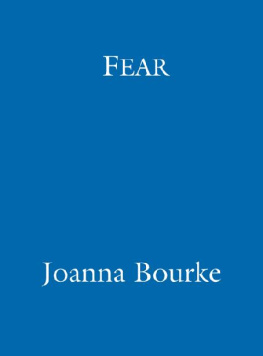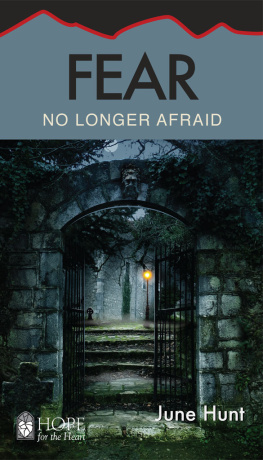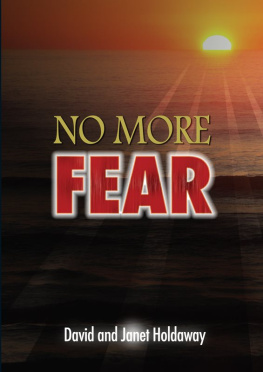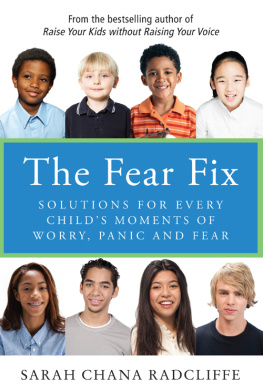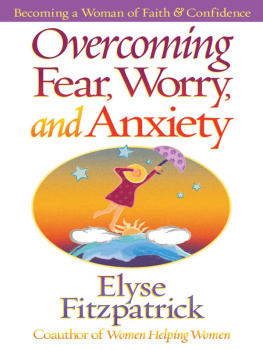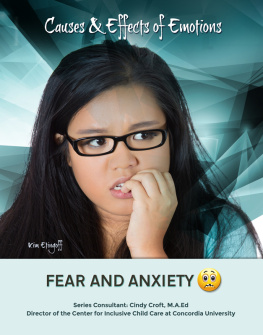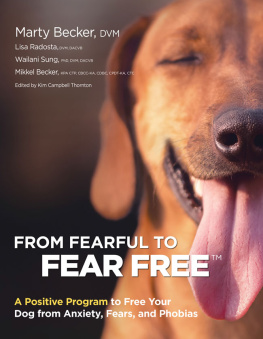Published by Virago
ISBN: 978 0 34900 692 5
Copyright 2005 Joanna Bourke
The moral right of the author has been asserted.
All rights reserved. No part of this publication may be reproduced, stored in a retrieval system, or transmitted, in any form or by any means, without the prior permission in writing of the publisher.
The publisher is not responsible for websites (or their content) that are not owned by the publisher.
Virago
Little, Brown Book Group
100 Victoria Embankment
London, EC4Y 0DY
www.littlebrown.co.uk
www.hachette.co.uk
For Costas
Contents
A few years ago, with fear and trembling, I set out to confront the most pervasive emotion of modern society: fear. Politically, the world was a different place then. It was before 9/11, when aeroplanes hijacked by terrorists crashed into the World Trade Center and the Pentagon. But personally, too, that was a more innocent time, before I was diagnosed with a life-threatening illness and reminded of my own mortality. The past seemed safer. Within the austere shelter of dozens of libraries and archives, I spilled the contents of other peoples lives on to my desk, and voyeuristically eavesdropped as they confessed to feeling scared. Self-proclaimed specialists in emotional management could be heard counselling these timid individuals. Often, however, those writers who preached secular gospels of fear not were found to wallow in scaremongering. People everywhere seemed very apprehensive. Despite the distance in time and place, their frightened stammerings were sometimes deafening; at other times they admitted to their anxieties in faint, hesitant whisperings.
Death and disaster; nightmares and phobias; new killing techniques and dangerous technologies; treacherous bodies a seemingly endless range of terrifying trials and tribulations seemed to face people in the twentieth century. Worse: there were times when all of history seemed to be reciting a traumatic script, devoid of answers or sense. On these occasions peoples terror was so overwhelming that their most fundamental identities were in danger of being engulfed. It took some time to notice the astounding creativity with which these scared men, women and children made sense of their predicament and remade their world in the wake of the crippling energy of fear. Looking at our societys fears, in both their past and present manifestations, enables us to meditate on the future. It is a future of our choosing.
Nevertheless, since I completed this book some threats that sparked great trepidation in the past have grown exponentially. The spectre of the Terrorist has taken on a god-like power, equivalent to the plague of earlier times or the Satan of religion. The proliferation of surveillance systems, the persecution of immigrants, the giddy boasting about the need for pre-emptive strikes are some of the results of this panic. We now use terror-speak to justify terrorising others. As a result, the science and practice of destruction has made rapid and alarming strides in the past few years. In the twenty-first century we must consider the possibility that the most frightening peril is the one we are in the process of forging. Wars in Afghanistan and Iraq have reminded us that we are perpetrators of violence against others, as well as being the victims of terrorist brutality. Torture is now routinely justified, not only in scruffy tabloids but also in supposedly reputable legal circles. The revulsion generated by the pornographic torture snapshots taken by American personnel in the Abu Ghraib prison in 2004 rapidly subsided: only a few people observed the relative indifference expressed in the press when equally shocking photographs of bound and hooded prisoners languishing in a legal no mans land in Guantnamo Bay were published. The routine portrayal of violent death in the mass media has blunted sensibilities: when hearing about real-life viciousness we may feel pity or distaste, but when we identify the emotion of fear it is our fear that concerns us. It is the fear of something that may befall us, rather than fear for others, those people on whom we inflict suffering. Authoritarian, indiscriminate and disproportionate responses have become the norm. Public policy and private lives have become fear-bound; fear has become the emotion through which public life is administered. It is time we returned to a politics which feared for the lives of others, near and far. Although fear is humanitys inheritance, trembling is our testament. And we must always tremble in the face of the stranger glimpsed beneath the rubble of history.
Some of these strangers albeit British and American ones are encountered in this book. It would have been impossible to study every type of fear experienced in the past one and a half centuries. Every time I opened a book or even talked to a friend over dinner, a new fear emerged. For example, I became obsessed with the history of scruples, or the excessive fear of God, and would quite happily have penned an entire chapter nay, an entire book on the topic. But in the end I had to admit that, in modernity, this was a decidedly minority anxiety. Some friends wanted a lengthy discussion of their fear of flying; others urged me to address existential anxieties relating to the loss of social status; still others wanted more discussion of gothic fiction and horror films. There was also much that could have been said about the appeal of roller-coasters and extreme sports. I resisted such temptations.
Instead, this book moves in broad chronological order through some of the prevailing fears and anxieties expressed by British and American individuals in the past. The fear of death and dying is a constant presence in history (for some commentators it is at the core of every fear), so it is appropriate that we begin with some of the peculiar characteristics of the fear of death in the nineteenth century. Near the end of the book we return to this theme in the context of contemporary death and the ways dying people today deal with their sense of dread. The sudden apprehension of life-threatening events is also addressed: how have individuals and groups come to terms with the senseless, unfair even, nature of disasters? What difference does it make when the calamity is man-made?
The second part of the book focuses much more on individual responses: the defenceless child, the nightmare sufferer and the phobic individual have all been central to psychological and psychiatric understandings of emotions, particularly in the early decades of the twentieth century. In the interwar years, as we shall see in the third part of the book, the mass media take a prominent role in inciting panic. In contrast, by the middle of the twentieth century military might indisputably trumped all other fear stimulants: arguably, modernitys most terrifying creations are shrapnel and nuclear bombs. Nowhere is the ability to inspire terror more persuasive than in this bruising encounter between technology and corporeality. In the fourth part, therefore, we look at three zones of confrontation: the battlefield, the city under bombardment and the borderless nuclear target. Humanitys entire wrath focuses upon puny skeletons.
In the fifth part we finally turn to those contemporary anxieties related to crime, disease, pain and the rape of the environment. The book concludes with a meditation on terrorism and the globalisation of risk. Throughout, fear is portrayed as a powerful driving force in the history of humanity. Its spectre cannot be ignored.
I have many people to thank. The people at Virago made this book possible. Particular thanks must go to Tim Whiting, Elise Dillsworth, Richard Dawes and Kirsteen Brace. I am grateful to my agent, Andrew Wylie, and to the patient labours of Michal Shavit. As always, my family are never stinting in their encouragement, even while disagreeing with many conclusions. Thanks to my parents, siblings and precocious nieces and nephews. Many people contributed to this book by asking pertinent questions in seminars and conferences, as well as over drinks afterwards: I wish I could thank each one of you by name. But special gratitude must go to a number of my comrades in fear and anxiety, particularly Effi Avdela, Alexandra Bakalaki, Sean Brady, Vincent Brome, Nicholas Brown, Charles and Caroline Charlton, Roger Cooter, Marianne Elliott, Richard Evans, David Feldman, Alan Forth, Aubrey Greenwood, Marybeth Hamilton, Vanessa Harding, John Harwood, Robin Haines, Eric Hobsbawm, Michael Hunter, Matthew Innes, Maria Komninos, Eric Leed, Mary-Lou Legg, Christos Lyrintzis, Shaun McVeigh, George Mosse, Avner Offer, Akis Papataxiarchis, Teddy Paradellis, Maria Paschalidi, Dorothy Porter, Robin and Heather Prior, Sue Rickard, Peter Robinson, Hilary Sapire, Naoko Shimazu, F. B. Smith, Frank Trentmann, Kosmas Tsokhas, Gregory Tychopoulos, Julie Wheelwright and Jay Winter. Aglaia Komninos and Phaedra Douzina-Balalaki not only lent a hand compiling the bibliography, but also helped me to laugh at a great many of my worries. But it is to Costas Douzinas that I dedicate this book.

